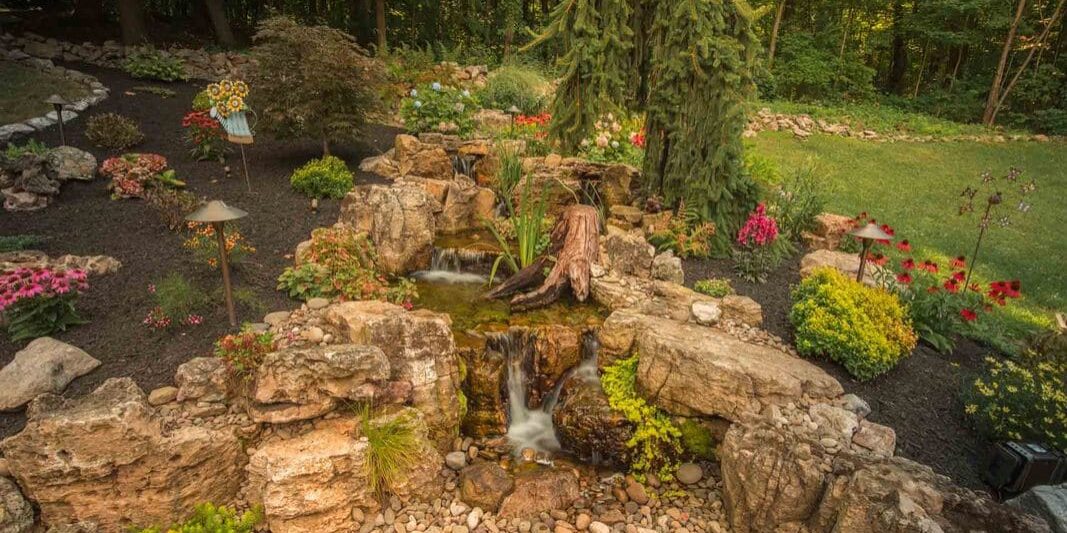
If you are considering a backyard waterfall, There are many steps of building to consider. The first question to consider is whether you want to build it yourself, or hire a contractor. While it is obvious that money can be saved with a DIY waterfalls, it may be difficult to find accurate comparison between a DIY waterfalls and a professionally installed one.
What does it cost DIY vs hiring a professional? A DIY kit for a backyard waterfall can be purchased for much cheaper than a professional can be hired. Like many artistic enterprises, the value of a professionally created waterfall will be much more than a do-it-yourselfer’s attempt at the same creation.
If you choose to pursue a DIY waterfalls kit, here are a few things to consider before starting.
What does it cost DIY vs hiring a professional? A DIY kit for a backyard waterfall can be purchased for much cheaper than a professional can be hired. Like many artistic enterprises, the value of a professionally created waterfall will be much more than a do-it-yourselfer’s attempt at the same creation.
If you choose to pursue a DIY waterfalls kit, here are a few things to consider before starting.
Labor. No matter how large or small your backyard waterfall, construction will require heavy lifting and digging. Moving stone and rocks for the waterfall is rugged work; so make sure you are prepared for some hard work before you begin. Tools and machinery. Depending on the size of waterfall you construct, it may be useful to have a backhoe or excavator to do some of the heavy digging and lifting for you. Shovels, picks, and digging bars are are necessary tools, along with a wheelbarrow and buckets, for moving material. An array of small power tools and hand tools will also be needed. Requirements for these small tools will vary based on the kit chosen. Materials. When you purchase DIY kit, it will provide all the components necessary for construction. You will still need rocks of various sizes, gravel or river stone, and topsoil. These materials are not included in the purchase price of a waterfall kit, and must be purchased or sources separately. Experience. There are many “tricks to the trade” that can only be learned with practice and years of learning. Much of the knowledge contained in a beautifully constructed waterfalls is hidden out of sight. Even builders with dozens of successfully built water features still occasionally run into unforeseen complexities that may cause leaks or other problems. Hire a professional with experience and he may prevent many of the frustrations that first time waterfall builders face.
So, you want to begin construction of your backyard waterfall; Where do you begin?
Actually, “where” is the first step to consider. You’ll want to chose an area with natural slope to aide the flow of the waterfall. Many people chose an empty corner or low spot that needs “filled in with something.” Orient your waterfalls to a place near your house where you can enjoy it through the four seasons. It is better if you can construct it near to the house, where the sound reaches indoors. Stand in your kitchen or bedroom and chose a spot that can be seen from inside.
Actually, “where” is the first step to consider. You’ll want to chose an area with natural slope to aide the flow of the waterfall. Many people chose an empty corner or low spot that needs “filled in with something.” Orient your waterfalls to a place near your house where you can enjoy it through the four seasons. It is better if you can construct it near to the house, where the sound reaches indoors. Stand in your kitchen or bedroom and chose a spot that can be seen from inside.
Excavation.
Once the location and position of your waterfalls is decided, it’s time to begin digging. The size and depth of your basin will be determined by your waterfall kit size. all the dirt from excavation can be used to increase the mound for the waterfalls. Different sizes of water features may have different basins. On smaller waterfalls, a preformed rigid plastic basin can be used. For Larger pondless waterfalls, Basins will be constructed using EPDM liner and Aquablocs.
After the basin is completed, you can begin digging the stream and waterfall areas. Calculate how long your stream will be based on the liner size you have available. Don’t forget to include the vertical distance to be measured for each waterfall. Dig your stream bed in a series of “steps” or shelves. Each step will become a waterfall. How high these waterfalls should be will be dictated by the size of rocks you will be using for construction. Larger rocks are necessary for higher waterfalls. Don’t try stacking rocks to create waterfalls. If one or two rocks isn’t high enough to make the waterfall you want, you need bigger rocks, or a smaller waterfall. Let the rocks shape your waterfalls.
When your stream and waterfalls have been excavated satisfactorily, lay out your liner as planned. You may wish to use underlayment fabric beneath the liner to protect it from punctures. Underlayment can also be used on top of the liner where larger rocks are placed. Carefully inspect the area where your stream liner transitions to your basin. Overlaps are risky, and prone to leaks. Extra care today may prevent ripping a part a leaking water feature tomorrow.
Once the location and position of your waterfalls is decided, it’s time to begin digging. The size and depth of your basin will be determined by your waterfall kit size. all the dirt from excavation can be used to increase the mound for the waterfalls. Different sizes of water features may have different basins. On smaller waterfalls, a preformed rigid plastic basin can be used. For Larger pondless waterfalls, Basins will be constructed using EPDM liner and Aquablocs.
After the basin is completed, you can begin digging the stream and waterfall areas. Calculate how long your stream will be based on the liner size you have available. Don’t forget to include the vertical distance to be measured for each waterfall. Dig your stream bed in a series of “steps” or shelves. Each step will become a waterfall. How high these waterfalls should be will be dictated by the size of rocks you will be using for construction. Larger rocks are necessary for higher waterfalls. Don’t try stacking rocks to create waterfalls. If one or two rocks isn’t high enough to make the waterfall you want, you need bigger rocks, or a smaller waterfall. Let the rocks shape your waterfalls.
When your stream and waterfalls have been excavated satisfactorily, lay out your liner as planned. You may wish to use underlayment fabric beneath the liner to protect it from punctures. Underlayment can also be used on top of the liner where larger rocks are placed. Carefully inspect the area where your stream liner transitions to your basin. Overlaps are risky, and prone to leaks. Extra care today may prevent ripping a part a leaking water feature tomorrow.
Rock work.
This is the most labor intensive part of the build. Creativity is necessary for this phase of construction. Don’t get attached to a certain rock or design. If you can’t make a rock work like you wanted it, try a different rock. If you can’t make anything work, move on and work elsewhere for awhile. Frustration kills creativity, so don’t get bogged down by one rock or area.
Create your waterfalls first, then build between them. Set larger rocks to frame your waterfalls, then build between them with smaller rocks. Whenever possible, use fewer, larger rocks as opposed to more, smaller rocks. Larger rocks will yield more stability, and have more aesthetic affect.
Use waterfall foam to seal between rocks to direct water over the waterfalls, channeling the stream where you want it. This foam is NOT waterproof. Foam will not prevent leaks, or seal liner together. It can be used to direct water, but not stop it.
This is the most labor intensive part of the build. Creativity is necessary for this phase of construction. Don’t get attached to a certain rock or design. If you can’t make a rock work like you wanted it, try a different rock. If you can’t make anything work, move on and work elsewhere for awhile. Frustration kills creativity, so don’t get bogged down by one rock or area.
Create your waterfalls first, then build between them. Set larger rocks to frame your waterfalls, then build between them with smaller rocks. Whenever possible, use fewer, larger rocks as opposed to more, smaller rocks. Larger rocks will yield more stability, and have more aesthetic affect.
Use waterfall foam to seal between rocks to direct water over the waterfalls, channeling the stream where you want it. This foam is NOT waterproof. Foam will not prevent leaks, or seal liner together. It can be used to direct water, but not stop it.
Plumbing and components.
At some point during the build, you’ll need to install the pump and plumbing for the waterfall. You’ll need to bury a pipe from the pump vault in the basin, to the spillway at the top. its best to bury this pipe before all edges and details are completed. The spillway at the top should be installed in combination with the rock work for the top waterfall. Let rocks and spillway work together to shape the last waterfall.
At some point during the build, you’ll need to install the pump and plumbing for the waterfall. You’ll need to bury a pipe from the pump vault in the basin, to the spillway at the top. its best to bury this pipe before all edges and details are completed. The spillway at the top should be installed in combination with the rock work for the top waterfall. Let rocks and spillway work together to shape the last waterfall.
Details and edge work.
It’s best to run your waterfall before finishing all edges and details. Once all rock work is done and foam has dried, turn on the waterfall and examine everything closely. Check for low liner edges. Make sure you have several inches of liner above water level. check all the waterfalls where water changes elevation. It is easy for water to follow a path out over the liner in these transition areas. Once you are satisfied with these critical areas, you can finish all the aesthetic details. Tuck the liner out of sight in the soil on the berms. Add driftwood, gravel, and plants as you wish. If you want to add lights to your water feature, install them once you have seen how the water flows.
It’s best to run your waterfall before finishing all edges and details. Once all rock work is done and foam has dried, turn on the waterfall and examine everything closely. Check for low liner edges. Make sure you have several inches of liner above water level. check all the waterfalls where water changes elevation. It is easy for water to follow a path out over the liner in these transition areas. Once you are satisfied with these critical areas, you can finish all the aesthetic details. Tuck the liner out of sight in the soil on the berms. Add driftwood, gravel, and plants as you wish. If you want to add lights to your water feature, install them once you have seen how the water flows.
With the completion of your backyard waterfall, you can relax and enjoy all the beautiful sights and sounds of water. Monitor the water level in the basin. If you need to refill it frequently, There is probably a leak somewhere. check the soil around the waterfalls for damp areas that may indicate leaking.
If you are interested in having Tussey Landscaping create a pondless waterfall in your backyard, contact us today to begin the conversation.
